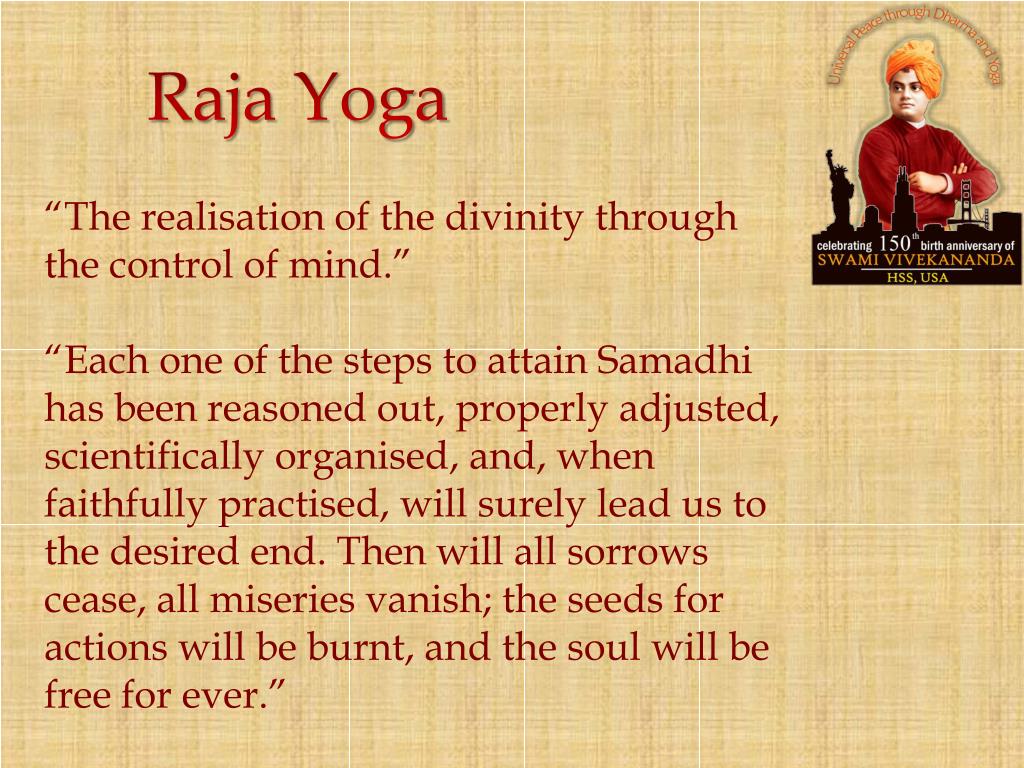
#Raja yoga swami vivekananda how to#
How to transcend the senses without disturbing the health is what we want to learn.

There are certain vibrations of light too slow to become visible then as they get faster, we see them as light and then they get too fast for us to see them at all.

These three planes can be understood by considering the vibrations of light or sound. The whole theory of Yoga is to go beyond the mind. Of men, the Yogi alone is superconscious. Our mind is acting on three planes: the subconscious, conscious, and superconscious. Whatever is beyond the five senses must also be experienced in order to become true to us. We all use it, but how sadly we waste it! The first doctrine in the preparatory stage is that all knowledge is the outcome of experience. Mind is very fine matter it is the instrument for manifesting Prana. In reality, and at the back of all things, every being is equal. Intelligence is always trying to manifest itself, and in order to do this it is creating minds and bodies of different degrees of development. When intelligence is perfect, we get the Incarnation - the Christ. But the intelligence we see around us is always imperfect. The Atman is pure intelligence controlling and directing Prana. Behind all is the Atman which never dies. The body is mortal and the mind is mortal both, being compounds, must die. Prana is the driving power of the world, and can be seen in every manifestation of life. Behind the mind is Âtman which takes hold of the Prana. Mind is the great instrument for using the Prana. The name of the energy in the universe is Prâna, which is the force residing in these elements. They are all evoked out of one primal element, which is very finest ether. The theory of creation is that matter is subject to five conditions: ether, luminous ether, gaseous, liquid, and solid.

According to De Michelis, Vivekananda's ideas on raja yoga mainly consists of two different models, with sometimes a third "mode of thought".(These lessons and those on Bhakti-Yoga that follow are made out of class notes preserved in England - Ed.) Vivekananda's interpretation of Patanjali's Yoga Sutras is mostly based on the part on astanga yoga, the eight limbs of yoga described in the Sadhana Pada or practice part. The other three yogas are the classical karma yoga, bhakti yoga, and jnana yoga. An important element in his adaptation of Hindu religiosity was the introduction of his four yoga's model, which includes raja yoga, his interpretation of Patanjali's Yoga Sutras, which offered a practical means to realize the divine force within which is central to modern Western esotericism.

Vivekananda adapted traditional Hindu ideas and religiosity to suit the needs and understandings of his Western audiences, who were especially attracted by and familiar with Western esoteric traditions and movements like Transcendentalism and New Thought. It presents Vivekananda's understanding and interpretation of Patanjali's Yoga Sutras, "and a selection of hathayoga teachings on the basis of the beliefs that he shared with his students." These included elements from traditional Hinduism, but also ideas from Western science, Idealism, and "the Neo-Vedantic esotericism of the Brahmo Samaj and Western occultism," including mesmerism and "American Harmonial religion".
#Raja yoga swami vivekananda plus#
Raja Yoga contains transcripts of lectures by Vivekananda on "Raja Yoga", his interpretation of Patanjali's Yoga Sutras, and a "rather free translation" of Patanjali's Yoga Sutras plus Vivekananda's commentaries, which also was a series of talks.


 0 kommentar(er)
0 kommentar(er)
